 klaus-michael schneider
klaus-michael schneider
Keywords: education | colombia |
Links: FOTW homepage | search | disclaimer and copyright | write us | mirrors

Last modified: 2021-08-26 by  klaus-michael schneider
klaus-michael schneider
Keywords: education | colombia |
Links: FOTW homepage |
search |
disclaimer and copyright |
write us |
mirrors
See also:
 image by Ivan Sache, 5 January 2009
image by Ivan Sache, 5 January 2009
"Colegio San Patricio" was founded in 1959 in
Bogotá by Emma Gaviria de Uribe, as "St. Patrick
School".
The flag of the institute, as shown graphically and described on
the website
of the institute, is green with a thin vertical white line
near the fly and two thin horizontal white lines near the bottom,
and, in the middle, a green clover leaf outlined in light green,
charged with the white letters "CSP" and placed on a
white disk. The flag was designed by educators of the institute.
The clover was used by St. Patrick, the patron saint of Ireland,
to explain the mystery of the Holy Trinity.
Ivan Sache, 5 January 2009
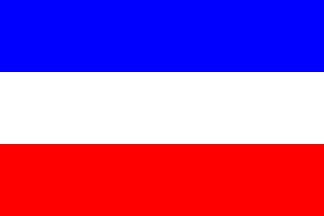 image by Ivan Sache, 28 July 2011
image by Ivan Sache, 28 July 2011
"Colegio San Pedro" is located in the municipality of Madrid, Cundinamarca
Department. The institute originates in "Escuela Agrícola de San Pedro", founded
in 1937 by Ruperto, Dolores and Rosa Elvira Melo Torres on their estate named
"La Hélida". The institute was then aimed at providing education to the
farmers' sons so that they could subsequently manage their own estates.
The Melo family subsequently donated the institute to the Tertiary Capuchins, a
congregation founded in 1889 by Luis Amigó Ferrer and active in Colombia since
1905.
The flag of the institute, as shown graphically on the institute's website, is
horizontally divided blue-white-red.
Source:http://www.colegiosanpedro.edu.co/index.htm
Ivan Sache, 28 July 2011
 image by Ivan Sache, 27 January 2009
image by Ivan Sache, 27 January 2009
"Colegio San Pedro Claver" is located in the Kennedy
borough, Bogotá. The institute is named after the Spanish Jesuit
St. Peter Claver (1580-1654, canonized on 15 September 1888), the
patron saint of slaves, of Colombia and of African Americans.
The flag of the institute, as shown graphically and described on
the website
of the institute, is horizontally divided blue-white-red with
three white stars outlined in black in the white stripe.
Blue represents humility and tolerance.
White represents inner and outer peace.
Red represents enthusiasm to teach and to be taught.
Ivan Sache, 27 January 2009
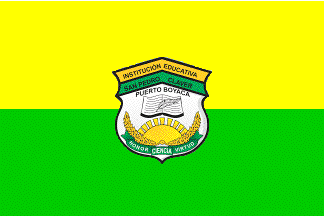 image by Ivan Sache, 18 March 2017
image by Ivan Sache, 18 March 2017
Institución Educativa San Pedro Claver was established in Puerto Boyacá,
Boyacá Department, on 13 February 1964 by Decree No. 98.
The institute is
named after the Spanish Jesuit St. Peter Claver (1580-1654, canonized on 15
September 1888), the patron saint of
slaves, of Colombia and of African
Americans.
The flag of the institute is horizontally divided yellow-green
with the institute's coat of arms in the center.
http://sanpedroclaverpuertoboyaca.blogspot.fr/p/1-presentacion.html -
Institute's website
Ivan Sache, 18 March 2017
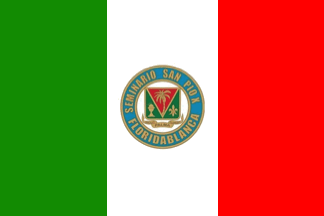 image by Ivan Sache, 10 February 2021
image by Ivan Sache, 10 February 2021
Colegio Seminario San Pio X, located at Floridablanca (Santander), was
recognized by Decree No. 7 issued on 2 February 1954 by Aníbal Muñoz Duque
(1908-1987), Bishop of Bucaramanga (1952-1959). Classes started on 11 February
1954.
The school is named after Pope Pius X (1835-1914, Pope in 1903,
canonized in 1954).
The flag of Colegio Seminario San Pio X is vertically
divided green-white-red with the school's coat of arms in the center.
Photo
https://www.facebook.com/Colseminariosanpiox/photos/2454087014848516
Video (with the coat of arms printed only on the flag's obverse)
https://www.youtube.com/watch?v=uPamL-7wIts
Green represents hope
that flourishes, grows green again and produces fruit in everyday's life.
White represents purity, innocence, sanctity, glee, grace and glory.
Red
represents fire, love and sacrifice.
The central, red part of the shield
features a palm symbolizing growth, fecundity, life and triumph.
The green
left part features a chalice with a host, symbolizing Eucharist.
The green,
right part features a fleur-de-lis symbolizing service to the community.
The
Latin motto, "Sicut palma florebit" ("It will flourish like a palm")
come from Psalm 92:12, "Justus sicut palma florebit, sicut cedrus in Libano
crescet" ("The righteous will flourish like a palm, they will grow like a
cedar in Lebanon").
https://cspx.edu.co/simbologia.html
School website
Ivan Sache,
10 February 2021
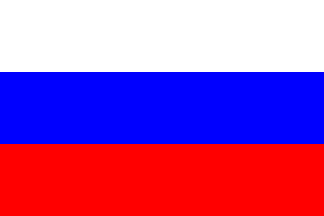 image by Ivan Sache, 17 September 2014
image by Ivan Sache, 17 September 2014
Institución Educativa San Pio X was established in 1971 in the La Enea
borough, part of the municipality of Manizales (Caldas Department), by the pries
Néstor Marulanda. The institute is named for Pope Pius X (1903-1914, canonized
on 29 May 1954 by Pope Pius XII).
The flag of the institute is horizontally divided white-blue-red. White is a
symbol of purity and limpidity. Blue is a symbol of the deepness of the soul and
of the immensity of knowledge. Red is symbol of the power of the student's
spirit, of fraternity, and of dynamism.
Source:
http://ptasanpiox.blogspot.fr/p/institucion-educativa-sanpiox-manizales.html
- Institute's website
Ivan Sache, 17 September 2014
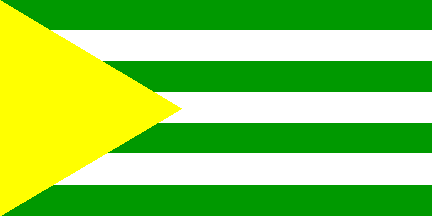 image by Ivan Sache, 04 December 2014
image by Ivan Sache, 04 December 2014
Instituto Técnico San Rafael was established in 1944 in Manizales (Caldas
Department) by the Tertiary Capuchins, a congregation founded in 1889 by Luis
Amigó Ferrer and active in Colombia since 1905. Rafael Salazar and his wife
Leonor offered the estate "La Suiza" to house the institute.
The flag of the institute is presented in the institute's Etiquette Guidebook as
horizontally divided in seven stripes, in turn green and white, with a yellow
triangle placed along the hoist. The seven stripes represents Mary' seven pains.
Green is a symbol of the youth while white is a symbol of peace. Yellow is a
symbol of virtue.
Source:
http://www.institutosanrafael.edu.co/dependencias/coor-convivencia/manual-de-convivencia.html
- Institute's website
Ivan Sache, 04 December 2014